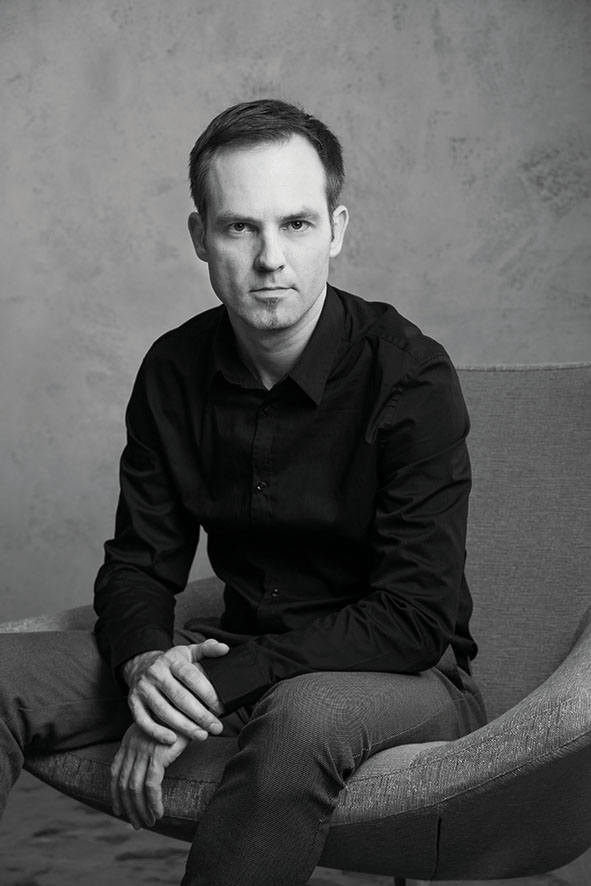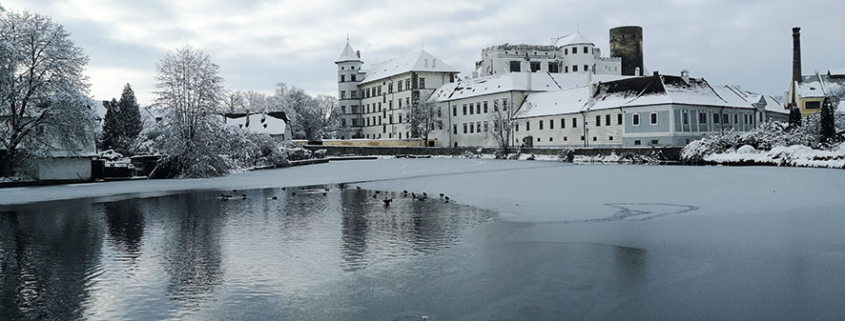 Jindřichův Hradec has long struggled with the absence of a city architect. Last year, a selection procedure was finally held and was attended by 13 candidates.
Jindřichův Hradec has long struggled with the absence of a city architect. Last year, a selection procedure was finally held and was attended by 13 candidates.
The winner was Ing. arch. Lukáš Soukup, a graduate of the Faculty of Architecture of the Czech Technical University Prague, who worked there as a lecturer in doc. Rothbauer’s studio. Since 2011, he has been authorized by the Czech Chamber of Architects. He has experience from an architectural studio, a development company and also experience gained during an internship in Tampere, Finland. He currently works for the international real estate and consultancy company Knight Frank, where he manages the construction of office buildings and specialist opinions from the areas of architecture and urban planning.
How did you convince the committee that your vision of a city architect’s activity is best for Jindřichův Hradec? Did you bet on tourism where there is the third largest castle complex in the Czech Republic following Prague and Český Krumlov?
I think Jindřichův Hradec as such is not a classic tourist destination. You can apply double standards there: On the one hand, the town potentially loses income from the tourist trade but, on the other hand, it was spared the situation in Prague centre, for instance, which is considerably damaged due to the number of tourists and stalls with souvenirs with no relation to the city and the place (for instance Russian fur hats and other items that, in my opinion, have nothing to do on the Royal Route).
So, where do you perceive the potential of the town?
The town centre is romantic – with many historically valuable and well-preserved buildings. But at the same time, more conceptual interventions in individual, mostly public spaces, are needed. I myself have an idea for a better background for residents as well as tourists. According to statistics, their visits mainly lead them to the castle grounds and the rest of the town seems slightly neglected.
And other fields aside from tourism?
I have a feeling that the town offers relatively few pleasant outdoor places that would allow for just sitting quietly or for some other activities even when it comes to its inhabitants. There is no comprehensive system of greenery, no suitable orientation system, etc.
What do you consider to be the most important thing at the moment?
There is no comprehensive transport system or parking in the town centre or in its wider surroundings. The cycleways do not have any logical connection to individual peripheries, especially to the Vajgar and Hvězdárna housing estates, which requires long-term care and conceptual thinking. If we start to look into it now, we will be able to leave something to our children and grandchildren. Something that we are able to prepare within the scope of just a few years.
How did the selection procedure actually proceed? Can you describe it further?
The first round of the selection procedure consisted of meeting formal prerequisites, such as university education, authorization and some practice. The second round included personal interviews with the presentation of a common task, which was to design a solution for the Ladislav Stehna Embankment on the bank of the Vajgar Lake. The next subject for discussion was the applicant’s awareness of Jindřichův Hradec and his ideas as to how to utilise the town’s potential. For instance, the chateau brewery – right next to the chateau – is situated in the protected town centre and is difficult to access. This is currently one of the biggest problems in historic centres of other Czech towns as well. Any function you place here will require an access. At the construction stage, it will require the availability of equipment, supply of material, etc. Even the subsequent operation can cause a disproportionate burden on the protected centre, if not even maybe collapse. This needs to be taken into consideration at the beginning when setting up the building programme. Reconstruction as such is expensive but that is nothing atypical. What I see decisive is a correctly chosen function and naturally project funding, ideally divided into stages.
Let’s go back to your proposal for the use of the Ladislav Stehna Embankment.
It’s a huge opportunity. However, the idea that the embankment will be reconstructed and that tourists will thus start going there is wrong. We need to take a step back and think about the concept of transport solution within the town and its surroundings. I think that that is the most important, not only here, but in most Czech towns. As for Jindřichův Hradec, renovations took place in the second half of the 20th century where many of which were not entirely pleasing. One of the less successful is the road along the Vajgar Lake, the Ladislav Stehna Embankment. According to traffic statistics, several thousand cars go through here daily in latter years. The traffic load is disproportionate to the location and if traffic is not prevented and reduced to a necessary minimum, the embankment will remain cut off from the town centre.
What do you find crucial then?
Considering the solution and concept of transport in the centre, the wider town centre and its surroundings. To try to adapt the centre more to the needs of the population in the form of gradual measures. Let’s realize that it is very easy to walk in a town of this size. I consider this to be one of the main qualities of a town such as Jindřichův Hradec, where there is also an optimal terrain for cycling. That is what I really enjoy about it.
Does this mean a priority modification to the transport solution and the embankment as such?
It will certainly be necessary to amend urban greenery – part of the town does not even hold the status of green area but, according to the outline plan, it is ‘insulating greenery’. That means that maintenance of the areas and access to them are subject to this. This is a matter that should also be addressed. Residents need to be more involved in this process and where possible, it is also necessary to come up with other barriers than the existent steel railings between the Vajgar Lake and the sidewalk for cyclists and pedestrians. As you walk through there you will probably realize that pedestrian crossings are not in places where it is logical in connection with pedestrian routes, but are located in places common from the point of view of comfortable driving.
How is it related to the historical centre?
From my point of view, the transport solution used in a town with more than 20,000 inhabitants corresponds conceptually with the 1960s. However, from today’s point of view regarding the use of public areas I think that this solution is outdated, obsolete and needs to be modified.
So, how should a town of this size work optimally – including visitors?
I would certainly not build the quality of the town and life in it on tourism. I don’t think it is the most important thing for such a town. I believe the city as such should first and foremost be a pleasant place for its inhabitants. In this respect, Jindřichův Hradec is smaller than Prague and Brno, etc…, but still experiences similar trends as West European towns, this being the displacement of the centre. Based on available figures I know that in the last few decades, the number of permanent residents has reduced to approximately one third. And then comes the classic issues – it is difficult to park here, it is difficult to shop, there is noise at night, which is something you do not want for family life. These issues bother your life so you would rather move to the outskirts where you can have a bigger house, bigger garden and perhaps also a garage. And the town centre as such can easily become a kind of mausoleum in the future, especially with the strengthening of tourism. This needs to be carefully thought through because the steps we take today will reap fruits for future generations. That means that the town cannot do without a more fundamental concept of tourism solution.
How do you personally see the total concept?
As soon as we manage to successfully plan and implement one public space, which can be, for instance, Míru Square or the Ladislav Stehna Embankment, I am convinced that we will set the standard for other public spaces within the town. If the residents identify with this space, we will be able to extend the quality solution to at least the rest of the centre. Another thing that I consider important is the solution of parking in the centre and the transport connection between the town periphery and the town centre. Therefore, it is a matter of solving the functioning of the combination of car traffic, cyclists and pedestrians. Building a town for cars, as we can, for instant, see in the town of Most, which today looks like a 1960s small American town, where walking through the centre on foot is difficult due to long distances because there are motorways, is a long-overdue model. It’s something that can be aesthetic for some, mostly architects, but research has long shown that the most pleasant are winding streets, pleasant nooks – and that’s why historic town centres are popular.
However, panel housing estates were built here on the outskirts, just as in other Czech towns. How do you see their inter connection with the historical centre?
A part of the centre was preserved thanks to the new prefabricated housing estates located outside the historical centre because in the 1960s, it was a great time to demolish twice as many houses as eventually happened. Of course, I’m sorry about those houses, but I can be relatively satisfied that no more was destroyed. I don’t want to perceive the housing estate negatively, especially when you see how many inhabitants in the Czech Republic live in panel houses. It’s a huge amount. And housing estates as such do not always have to be solved as so-called ‘rabbit hutches’, if you look at Brno – Lesná or other good examples, such as Prague – Pankrác with lower-storey houses, cultivated greenery, etc. The parterres of some buildings at the housing estates are lined with stone, somewhere there are works of art, accessible civic amenities and lots of greenery…
What do the housing estates in Jindřichův Hradec look like in this comparison?
Unfortunately, they are not that nice, but, on the other hand, there is greenery and it is close to the centre. I would not perceive it completely negatively. If they need anything, it is more cultivation of public areas and better connection to the centre for cyclists and pedestrians. What bothers me most in housing estates, not only those in Jindřichův Hradec, is the fact that they are often only visible from the historical centre. And it was enough to build two floors less or design the whole development in a different fashion.
Where do you see the real basis of each town?
In the locals and I think they are the ones who should be involved in what is being prepared by the town, especially with regards to long-term plans and investments. I think that it is a priority to give space to discussions in the form of panel meetings and present upcoming projects … everything must have a clear plan and the specific responsible person who is preparing the project must be determined. However, it is necessary to involve both the public and town residents because as a weekend visitor, I cannot have the same point of view as the locals and I am interested in the opinion of both children and youth, university students, mothers on maternity leave, pensioners and workers. They are the inhabitants of the town and they all have the right to have their say on these issues. How the concept will work once completed, what the town takes into account – all this can determine residents’ satisfaction with the town’s plans and gradual transformation and improvement. I don’t like to say problems, but the use of the potential that is there at the moment.
How do you yourself see the function of a city architect?
The main task is to actively participate in the concept of town development. At the same time, it is also important to popularize architecture and to convey the council’s plans to the inhabitants. At this time, Czech society lacks discussion as such. When someone disagrees with us, we take it as an invective and a personal attack. I myself got used to discussion when defending projects as an architect. I am convinced that when a logical counter-argument is heard, it will force me to rethink the solution. The issues that had not occurred to me till then can also be termed in this way. I see two options: You either defend the concept and confirm your opinion, or you do not defend it and therefore have to rethink the solution and rework it.
Is this about better communication then?
Communication is generally required: I do not yet know how the public will be involved in the discussion, but I hope that it will be as much as possible so that their views can be taken into account. The worst scenario I can imagine is that in a year – when you walk through Jindřichův Hradec – you will see residents laughing at the prepared solution and feeling that the person who came from elsewhere and never lived here spent their money and that they are not to be identified with the concepts and plans. That’s wrong and it certainly shouldn’t work that way. Towns are different, but problems recur. It is important that local people adapt to the upcoming projects. That is the key to success.
How do you want to help with regards to the solving of these difficulties?
In the future, I would like to address my former colleagues from the Faculty of Architecture and together assign selected tasks within the town as term work for students. This is the experience I had when working as a lecturer in the studio of Mr. Rothbauer, the senior lecturer, where we processed similar assignments of randomly selected towns. They were projects of individual buildings and groups of these buildings, but often also more extensive urbanism.
Arnošt Wagner / Photo: archive



